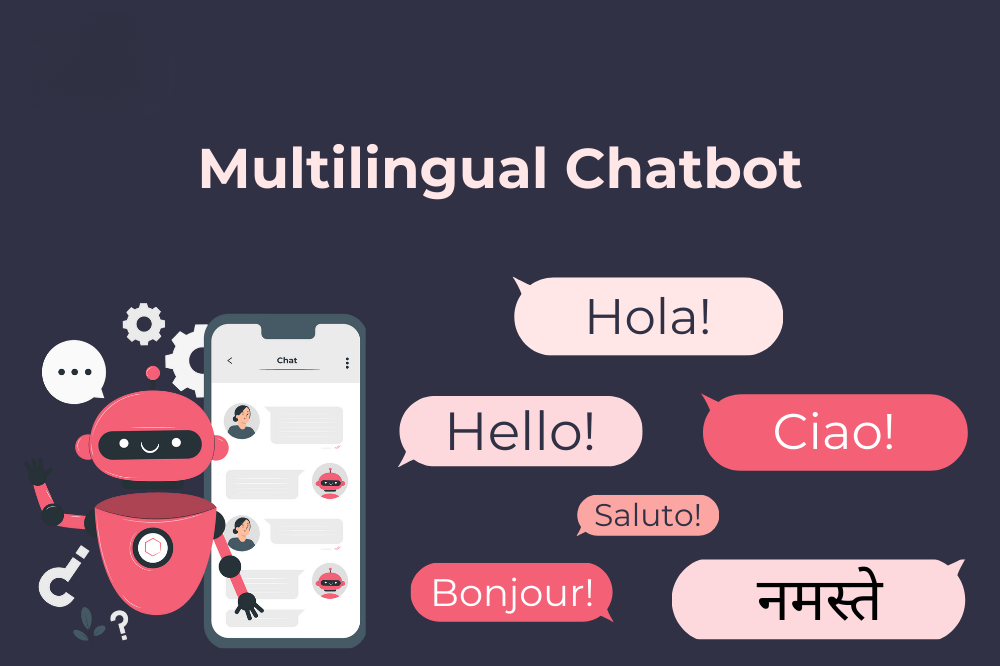
AI and Language: A Growth-Driving Duo
Imagine being on the verge of sealing a deal with a high-value customer, only for the conversation to fall apart due to a language barrier. Businesses lose potential clients every day simply because they cannot communicate in their preferred language.
Research shows that 76% of consumers prefer brands that engage with them in their native language. A multilingual chatbot eliminates this hurdle, enabling businesses to interact seamlessly with global audiences, boost engagement, and enhance conversions without the need for an extensive multilingual team.
This blog delves into the concept of multilingual chatbots, their benefits, best practices, challenges, and future trends. Let’s explore how they can transform customer interactions!
Understanding Multilingual Chatbots
A multilingual chatbot is an AI-powered assistant that interacts with users in multiple languages, helping businesses cater to diverse audiences. Instead of hiring multilingual customer support teams, businesses can deploy chatbots that automate interactions, improving efficiency and boosting revenue.
Essential Guidelines for Developing a Multilingual Chatbot
- Leverage AI-driven translation – Ensure responses are contextually accurate rather than relying on direct translations.
- Focus on high-demand languages – Analyze audience demographics to optimize the chatbot for the most spoken languages.
- Ensure consistency in brand messaging – Maintain uniformity in tone, terminology, and overall communication style.
- Support regional dialects – Enhance engagement by making interactions feel natural and culturally relevant.
- Integrate with messaging platforms – Prioritize chatbots that work seamlessly with WhatsApp, Facebook Messenger, and other popular communication channels.
🔍 Did you know? Over 175 million people interact with businesses via WhatsApp every day, making it a vital channel for automated customer support and sales.
Advantages of Implementing a Multilingual Chatbot
If your business only operates in one language, you may be missing out on a massive global audience. A multilingual chatbot ensures smooth interactions, improves accessibility, and maximizes conversions.
1. Transform Website Visitors into Customers
First impressions are crucial. If users don’t find their preferred language on your website, they’re likely to leave. A multilingual chatbot instantly engages visitors, answers their queries, and guides them toward a purchase.
2. Deliver Personalized Sales Interactions
71% of consumers expect personalized experiences, and companies that meet this demand often see a 40% revenue boost. AI-driven chatbots tailor conversations to suit customer preferences, resulting in higher engagement and better conversion rates.
3. Shorten the Sales Cycle
Speed matters—66% of millennial buyers expect instant responses. A multilingual chatbot provides real-time product details, answers queries, and schedules appointments, ensuring a seamless sales journey.
4. Expand to Global Markets with Ease
Businesses that embrace multilingual AI-powered automation can tap into new revenue streams effortlessly. With support for multiple languages, your business can engage with international customers without barriers.
5. Automate Lead Qualification
By filtering and categorizing leads based on responses, a multilingual chatbot helps sales teams focus on high-potential customers. This streamlines operations and accelerates the conversion process.
6. Reduce Customer Support Costs
Rather than hiring multilingual support agents, businesses can deploy AI-powered chatbots to handle interactions around the clock. This significantly cuts down payroll expenses while ensuring excellent customer service.
7. Gain a Competitive Edge
85% of buyers prefer brands that offer superior customer support. A multilingual chatbot enhances customer experience by providing personalized, real-time interactions, giving your business an advantage over competitors.
Step-by-Step Guide to Building a Multilingual Chatbot
1. Get Started with a Business Messaging API
To implement a chatbot on platforms like WhatsApp, businesses need API access. This enables automation, chatbot integration, and enhanced communication capabilities.
2. Design a Structured Conversation Flow
- Identify key user interactions (e.g., FAQs, order tracking, customer support).
- Define conversation intents and decision trees.
- Use a chatbot builder to design an intuitive user experience.
3. Automate Responses with AI
- Implement AI-driven Natural Language Processing (NLP) to understand various languages.
- Train the chatbot with real-life user interactions for better accuracy.
- Integrate AI-based translation models to ensure high-quality multilingual responses.
4. Connect with CRM and Payment Platforms
- Sync chatbot data with CRM tools for better customer management.
- Integrate with e-commerce platforms and payment gateways to enable transactions.
- Automate marketing follow-ups and retargeting strategies.
5. Test, Launch, and Optimize
- Conduct real-time testing across multiple languages.
- Track engagement metrics and refine chatbot responses.
- Regularly update the chatbot based on customer feedback and evolving trends.
Best Practices for Managing a Multilingual Chatbot
1. Prioritize Localization Over Direct Translation
Rather than translating word-for-word, adapt content to suit cultural nuances and regional preferences. Use localized greetings and conversational tones to make interactions feel more natural.
2. Implement AI-Based Language Detection
Instead of requiring users to select their language, integrate AI-based detection systems to automatically identify the user’s preferred language.
3. Use a Hybrid Approach (AI + Human Support)
For complex queries, enable seamless transitions from chatbot to human agents. Smart routing ensures that users are connected with support staff fluent in their language when necessary.
4. Optimize for Voice and Speech-to-Text
Voice search and voice-activated chatbots are on the rise. Enhance chatbot capabilities by integrating speech recognition technology for a more natural and user-friendly experience.
5. Continuously Update and Improve
Language evolves over time. Regularly update chatbot responses to incorporate new phrases, trends, and linguistic nuances. Conduct periodic testing to refine accuracy and improve engagement.
Challenges in Implementing Multilingual Chatbots
1. Language Complexity and Cultural Sensitivity
Translating words isn’t enough—a chatbot must understand cultural context and language nuances to provide meaningful responses.
2. Scaling Across Multiple Languages
Adding new languages increases complexity. AI-powered models must be continuously trained and optimized for effective communication.
3. Real-Time Language Switching
Users may switch between languages mid-conversation. Advanced NLP algorithms are required to ensure smooth transitions without disrupting the experience.
4. Limited Data for Some Languages
AI models rely on large datasets, and some languages have limited online resources, making training and implementation more challenging.
Future Trends in Multilingual Chatbots
1. Hyper-Personalization
Future chatbots will analyze user behavior and preferences to provide real-time, customized interactions that feel increasingly human-like.
2. Voice-Enabled AI Chatbots
The rise of voice search will lead to chatbots that can understand and respond to voice commands in multiple languages, improving accessibility and engagement.
3. AI-Driven Sentiment Analysis
Advanced AI will allow chatbots to detect emotions and tailor responses accordingly, further enhancing user experience.
Conclusion
Embracing multilingual chatbots can significantly enhance customer experience, break down communication barriers, and drive business growth. By implementing AI-driven automation, businesses can engage global audiences, boost sales, and stay ahead in a competitive market.
The future of customer engagement is multilingual—now is the time to adopt this game-changing technology!

